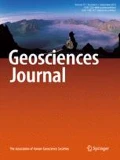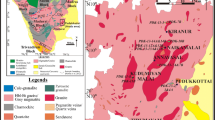Abstract
We report Rb−Sr and Sm−Nd isotope data to better constrain the origin of the Seoul granitic batholith in Uijongbu-Dongduchon-Pocheon area. The dominant rocks of the Seoul granitic batholith intruding the Precambrian Gyonggi massif are biotite granite and garnet biotite granite. Rb−Sr whole rock data define three subparallel lines in an isochron diagram, which is related to geography rather than to lithology. Biotite granite and garnet biotite granite from the northeastern part of the study area give an isochron age of 170.0±5.2 Ma with an initial Sr isotopic ratio of 0.71669±0.00043, while those from the central part give an isochron age of 167±19 Ma with an initial ratio of 0.71280±0.00075. On the other hand, three biotite granites from the northern part, having low Rb/Sr ratio, plot below the isochron of the central samples with a similar slope (∼168 Ma) and have calculated initial Sr isotopic ratios of 0.7102–0.7109. Whole rock Sm−Nd data do not show isochron relationship, nor do they show distinct initial isotopic ratios for different areas as defined by initial Sr isotope ratio. Calculated εNd (T=170 Ma) values range from −15.6 to −19.9 and are generally higher than those of basement gneisses (an average of −23.4) around the batholith. These isotope data indicate that three distinct magmas with different Sr but similar Nd isotope ratios intruded during middle Jurassic time to form the Seoul batholith in the study area. The Sr and Nd isotope data from the basement rocks of the Gyeonggi massif suggest that the initial Sr and Nd isotope data of the Seoul batholith can be explained by mixing of three components: the mantle component and two crust components with high and low87Sr/86Sr, which rules out the possibility of its origin from direct partial melting of basement rocks, but requires significant mantle input. The isotope data also suggest that geochemical differences (MnO, Rb, Sc, Nb, Y, and Yb contents) between biotite granite and garnet biotite granite in our previous major and trace element study might be related to some sort of fractionation in each magma.
Similar content being viewed by others
References
Arth, J.G., 1976, Behavior of trace elements during magmatic processes: a summary of theoretical models and their applications. Journal of Research U.S. Geological Survey, 4, 41–47.
Choo, S.H. and Kim, D.H., 1983, Rb/Sr age dating of the Gyeonggi gneiss complex in Anyang, Gapyeong, Yangsuri, and Yongduri areas. Research report 82-1-16, Korea Institute Energy and Resources, 79–102. (in Korean)
Fullagar, P.D. and Park, B.K., 1975, Rb−Sr study of granite and gneiss from Seoul, South Korea. Geological Society of America Bulletin, 86, 1579–1580.
GMIK (Geology and Mineralogy Institute of Korea), 1973, 1∶250,000 geological map of Korea, GMIK, Seoul, Korea.
Hong, Y.K., 1984, Petrology and geochemistry of Jurassic Seoul and Anyang Granites, Korea. Journal of Geological Society of Korea, 20, 51–71.
Irving, A.J. and Frey, F.A., 1978, Distribution of trace elements between garnet megacrysts and host volcanic liquids of kimberlitic to rhyolitic composition. Geochimica et Cosmochimica Acta, 42, 771–787.
Kim, O.J., 1971, Study on the intrusion epochs of younger granites and their bearing to orogenies in South Korea. Journal of Korean Institute of Mining Geology, 4, 1–9. (In Korean)
Kim, O.J., 1973, The stratigraphy and geologic structure of the metamorphic complex in the northwestern area of the Kyonggi massif. Journal of Korean Institute of Mining Geology, 6, 201–218. (in Korean)
Kwon, S.T., Cho, D.L., Lan, C.Y., Shin, K.B., Lee, T. and Mertzman S.A., 1994, Petrology and geochemistry of the Seoul granitic batholith. Journal of Petrological Society of Korea, 3, 109–127.
Kwon, S.-T. and Sagong, H., 1998, Uijeongbu circular structure of Seoul granitic batholith, Korea: ring dike origin of a Jurassic volcanic cauldron. Geoscience Journal, 2, 161–164.
Lan, C.Y., Shen, J.J. and Lee, T., 1986, Rb−Sr isotopic study of andesites from Lu-Tao, Lan-Hsu, and Hsiao-Lan-Hsu: eruption ages and isotopic heterogeneity. Bulletin of Institute of Earth Sciences, Academia Sinica, 6, 211–226.
Lan, C.-Y., Lee, T., Zhou, X.-H., Kwon, S.-T., 1995, Nd isotopic study of Precambrian basement of South Korea: evidence for Early Archean crust. Geology, 23, 249–252.
Lee, S.G., Shimizu, H., Masuda, A. and Song, Y.S., 1992, Crustal evolution of the precambrian basement in the Korean Peninsula. Journal of Petrological Society of Korea, 1, 124–131.
Ludwig, K.R., 1990, ISOPLOT: A plotting and regression program for radiogenic isotope data, for IBM-PC compatible computers. Version 2.12. U.S. Geological Survey Open-File Report 88-557, 31 p.
Na, K.C. and Lee, D.J., 1973, Preliminary age study of the Gyeonggi metamorphic belt by the Rb−Sr whole rock method. Journal of Geological Society of Korea, 9, 168–174.
Na, K.C., 1978, Regional metamorphism in the Gyeonggi Massif with comparative studies on the Yeoncheon and Ogcheon metamorphic belts (I). Journal of Geological Society of Korea, 14, 195–211.
Na, K.C., 1979, Regional metamorphism in the Gyeonggi Massif with comparative studies on the Yeoncheon and Ogcheon metamorphic belts (II). Journal of Geological Society of Korea, 15, 67–88.
Park, B.-K., 1972, Whole-rock rubidium-strontium age of the Seoul granite. Journal of Geological Society of Korea, 8, 156–161.
Steiger, R.H. and Jager, E., 1977, Subcommission on geochronology: Convention on the use of decay constants in geo- and cosmochronology. Earth and Planetary Science Letters, 36, 359–362.
Shen, J.J.S., Yang, H.J., Lan, C.Y. and Chen, C.H., 1993, The setting up of isotope dilution mass spectrometry for REE analysis. Journal of Geological Society of China, 36, 203–221.
Yun, H.-S., 1995, Occurrence and petrochemistry of the granites in the Pocheon-Euijeongbu area. Journal of Petrological Society of Korea, 4, 91–103. (in Korean)
Author information
Authors and Affiliations
Corresponding author
Rights and permissions
About this article
Cite this article
Kwon, S.T., Lan, C.Y. & Lee, T. Rb−Sr and Sm−Nd isotopic study of the Seoul granitic batholith in middle Korea. Geosci J 3, 107–114 (1999). https://doi.org/10.1007/BF02914266
Received:
Accepted:
Issue Date:
DOI: https://doi.org/10.1007/BF02914266




